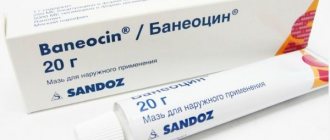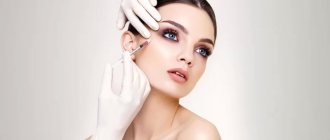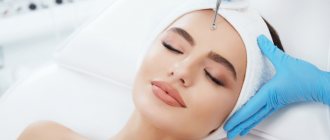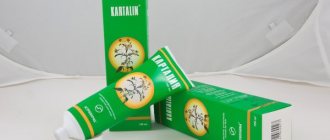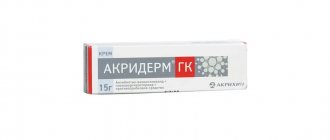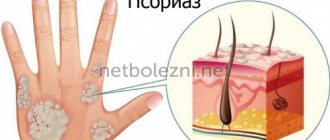Almost every person is faced with the problem of problematic skin, which manifests itself in the form of acne and other inflammatory formations on the skin. Very often, such a defect causes a large number of unpleasant sensations and reduces the normal course of life.
When acne occurs, it is necessary to carry out special treatment, which does not easily mask inflammation on the epidermis, but also eliminates the cause of its occurrence. Experts very often prescribe Baneocin for acne.
The use of the complex substance Baneocin allows you to quickly eliminate unpleasant symptoms and cleanse human skin. The drug is designed specifically for the care of problem skin and allows you to eliminate the most complex types of skin defects.
Pharmacodynamics and pharmacokinetics
Baneocin is an antimicrobial combination remedy used exclusively for topical (local) use and includes two antibacterial drugs, characterized by their pronounced bactericidal effect .
Neomycin is an aminoglycoside antibiotic bacterial protein synthesis . The activity of this antibacterial agent is manifested against many gram-positive and gram-negative bacterial microorganisms .
Bacitracin belongs to the group of polypeptide antibiotics that inhibit the replication processes of the bacterial cell membrane . The main antibacterial effect of this drug is observed against gram-positive microorganisms representing the genus Staphylococcus and Streptococcus , as well as against some gram-negative bacteria (resistance to bacitracin is very rarely formed).
The synergism (combined action) of these two antibacterial drugs leads to a significant increase in the therapeutic spectrum of action of bacitracin and an increase in its effectiveness against a number of microorganisms , in particular staphylococci .
When using the drug locally, absorption of its active ingredients, as a rule, is not observed (even when applied to damaged skin). However, at the time of therapy, their high concentration is detected in the skin.
This drug is characterized by good tissue tolerance , and therefore its use on large skin areas may cause systemic absorption.
General description of Baneocin
Baneocin is a product for external use, which is available in the form of ointment and powder. The two dosage forms are distinguished by the method of application and the content of excipients in the composition. There are two antibiotics as the main active components - bacitracin and neomycin.
The ointment includes such auxiliary elements as paraffin and lanolin, powder - starch containing up to 2% magnesium oxide. The product is available in tubes of 20 g and jars of 10 g.
The medicine is positioned as a drug with an antibacterial effect for the treatment of weeping and dry wounds of infectious and non-infectious origin.
Antibacterial substances in the composition have a bactericidal effect. They inhibit the synthesis of bacterial membranes and proteins, which leads to their death. The product is effective against streptococci and staphylococci, as well as some gram-negative bacteria.
Thanks to the combination of two antibiotics, a wide spectrum of drug activity is achieved against a number of pathogenic microorganisms. However, the medicine has many contraindications and the risk of side effects. Overdose is also possible.
Indications for use
The use of Baneocin ointment and Baneocin powder is indicated for the purpose of local therapy of infectious and inflammatory skin diseases that were caused by microorganisms sensitive to the active ingredients of the drug, including:
- of umbilical infection in newborns ;
- prevention of possible infectious complications after surgical ( dermatological ) manipulations, as additional therapy in the postoperative period after episiotomy , cauterization , tissue excision, treatment of weeping wounds , cracks and sutures ;
- treatment of local bacterial skin infections trophic ulcerative lesions of the lower extremities, contagious weeping impetigo , infected eczema , bacterial diaper dermatitis , including bacterial complications caused by Varicella zoster and Herpes simplex .
Who is it suitable for?
Baneocin in different forms has some differences in terms of indications. There are conditions for which a specific type of drug will be more effective.
In what cases is Baneocin ointment prescribed:
- focal lesions of the skin - carbuncles and boils, including those that occur after surgery;
- staphylococcal lesions, purulent wounds, severe folliculitis;
- limited bacterial infections, including leg ulcers, infected eczema, dermatosis, contagious impetigo;
- prevention of infection after surgery.
- Baneocin powder has the following indications for use:
- prevention of umbilical infection in children;
- prevention of infection after surgery;
- bacterial skin infections in limited areas of the skin.
After surgery, the drug is used in combination therapy. The drug is also often prescribed in cosmetic surgery and skin transplantation.
Contraindications
It is prohibited to use any of the dosage forms of the drug when:
- extensive skin lesions (due to the risk of an ototoxic effect manifested by hearing loss );
- personal hypersensitivity to neomycin , bacitracin or other aminoglycosides ;
- severe disorders of renal excretory function (due to renal or heart failure );
- diagnosed pathologies of the cochleo-vestibular system (if systemic absorption of the active ingredients of the drug is possible);
- diseases of the visual organs.
Release form of Baneocin and the advantages of each of them
The products are available in 2 types. The dosages of active substances in them are the same.
The ointment is yellowish, of uniform consistency. A complete analogue of the powder in composition and quantity of active ingredients.
The indication for use is the presence of lesions infected with pathogenic flora and the acceleration of their healing.
This dosage form is preferable to use when treating damaged cavities. The drug is applied to gauze swabs.
The ointment helps soften tissue; it is advisable to prescribe it to patients with wounds that heal with secondary intention.
Baneocin powder is yellowish, reminiscent of powder or powder. This dosage form is mainly used for healing of weeping wounds and sutures, when treating areas covered with mucous membrane, such as the perineum.
The drugs in both dosage forms have a bactericidal effect. Used to heal various types of damage. The choice of the type of remedy is the prerogative of the doctor.
Side effects
Baneocin ointment and Baneocin powder, as a rule, do not lead to any negative effects when used topically on small problem areas of the skin and mucous membranes, which is why the ointment and powder of this drug are recommended for use specifically for the treatment of local infectious diseases .
With prolonged use, allergic manifestations , including dry skin , redness , skin rash / itching . Mostly these phenomena occur similar to contact eczema , in half of the cases they are provoked by cross- allergy to other aminoglycosides and are observed quite rarely.
of systemic negative effects is allowed , in most cases noted in the treatment of extensive skin lesions, when there is a high possibility of absorption of the active ingredients of the drug and the occurrence of its nephrotoxic and ototoxic neuromuscular conduction disorders .
Positive properties of the drug and its effect
The use of the substance Baneocin allows you to achieve the following positive properties:
- The drug has a broad effect on the skin and helps eliminate various diseases of the epidermis;
- Antibiotics that are included in the composition are not addictive and can be used for a long time without reducing effectiveness;
- The active components of Baneocin do not penetrate deeply , therefore they have practically no ability to cause side symptoms;
- The result is achieved very quickly and lasts for a long time;
- The drug has the property of activating the natural processes of restoration of damaged cells and blocking their reoccurrence.
The drug can be used both locally and for large areas as directed. Does not have a negative effect on healthy cells upon contact during treatment.
Penetrating into the layers of the epidermis, it quickly eliminates harmful microbes and restores damaged cells. It is well tolerated by the body, so it can be used at an early age.
Advantages and disadvantages of application
A substance for external acne treatment has the following positive and negative qualities.
| Advantages: | Flaws: |
|
|
The effect of a substance on the skin may depend on the characteristics of the body and proper use, depending on the degree of damage to the skin.
Instructions for use of Baneocin (Method and dosage)
Baneocin powder, instructions for use
The drug in powder form is indicated for use 2-4 times a day with a thin layer of it on the affected skin areas.
In the case of treating burns that occupy more than 20% of the patient’s body surface, the powder can be used only once every 24 hours, especially if the patient has reduced renal function (due to the possible absorption of active ingredients into the systemic circulation).
When used topically, the maximum daily dosage of neomycin can be 1 gram, which corresponds to the use of 200 grams of powder per week. A repeated therapeutic course requires reducing the weekly maximum dosage by half (up to 100 grams).
Baneocin ointment, instructions for use
The drug in the form of an ointment is allowed for use 2-3 times a day, for which Baneocin ointment is applied in a thin layer to the affected areas of the skin. You can practice applying ointment under the bandage .
It is possible to use the ointment in the postoperative period as an additional therapeutic agent. Application of the drug directly to bandages is preferable in the case of local treatment of infected wounds and cavities (including surgical scars healed by secondary intention and bacterial infections of the external auditory canal without damage to the eardrum ).
Side effects
"Baneocin" is practically invisible on the skin and does not leave an oily film or unpleasant sensations when used.
If you apply it to rashes or affected areas pointwise , the drug will enter the blood in minimal quantities and will not affect the functioning of the kidneys, heart muscle, or nervous system.
In rare cases, in case of overdose, irritation, itching, and dry skin are observed in the treated areas. The use of the drug in case of individual intolerance may result in eczema.
If problems arise, you should stop using the product and immediately consult a dermatologist .
Interaction
If systemic absorption of the active ingredients of the drug is possible, parallel use of aminoglycosides or cephalosporins increases the risk of nephrotoxic phenomena .
The combined administration of Baneocin with Furosemide or Ethacrynic acid increases the possibility of nephrotoxic and ototoxic reactions.
With observed systemic absorption, the combined use of Baneocin with muscle relaxants , anesthetics and opioid analgesics can lead to the development of neuromuscular blockade .
cases of incompatibility of neomycin and bacitracin with other medications.
How to treat an umbilical wound
The powder is approved for use in children during the neonatal period. The drug is used only according to indications and in agreement with the pediatrician. In most cases, it is enough to use less serious antibacterial drugs to heal the navel.
The use of Baneocin for treatment is advisable:
- if the wound does not heal for a long time;
- the navel becomes wet, crusts form;
- the appearance of an unpleasant odor;
- the presence of purulent masses in the wound during healing;
- general poor condition of the baby, indicating an inflammatory process in the navel.
The pediatrician explains the procedure for treating with an antibacterial drug. Wound powder Baneocin is approved for healing the navel in the first days of a child’s life.
Standard rules for purulent wounds:
- Wash your hands, remove the diaper.
- Wash your stomach with boiled water at room temperature. The use of baby soap is allowed.
- Treat the navel with hydrogen peroxide. Blot off excess.
- Sprinkle the powder on the affected area.
- If possible, leave the child without a diaper or clothes. Allow the skin to absorb the healing agent.
The number of wound treatments with Baneocin is prescribed by the doctor. The standard recommendation in the instructions is 2–5 times a day. The duration of treatment should not exceed 7 days.
special instructions
In the case of using dosages of Baneocin that significantly exceed the recommended ones, due to the possible absorption of its active ingredients, it is necessary to pay attention to negative symptoms that may indicate ototoxic or nephrotoxic reactions.
Due to the increased risk of toxic effects in patients with observed / kidney pathologies, urine and blood together with audiometric studies , both before the start of therapy and during treatment .
If during therapy the possibility of absorption of the active ingredients of the drug is allowed (in case of extensive skin damage), then there is a need to control the possible formation of symptoms of neuromuscular blockade , especially in patients with myasthenia , other neuromuscular pathologies , as well as acidosis . If neuromuscular blockade it is recommended to prescribe neostigmine calcium supplements .
Long-term use of Baneocin requires monitoring for a possible excessive increase in the number of resistant microorganisms , sometimes with the need to prescribe appropriate therapy.
Long-term use of Baneocin for the treatment of children with liver / kidney , as well as the use of the drug to treat large areas of skin, must be previously agreed with a doctor.
If superinfection or allergic manifestations , Baneocin therapy should be discontinued.
Use in childhood
The use of Baneocin in childhood requires compliance with the following features:
- The substance is used from the first days of life on the recommendation of the attending physician;
- Application is carried out only on a specific area of the body, prohibited for large areas;
- It is recommended to use powder to treat the umbilical cord;
- Use is prohibited for diseases of internal organs, as well as for allergic dermatitis in a child.
Pediatricians recommend short-course treatment with Baneocin under the supervision of a specialist.
Analogs
Level 4 ATC code matches:
Bacitracin
Fucidin
Bactroban
Fusiderm
Sintomycin
Analogues of Baneocin ointment and powder are represented by medicinal products used for topical use (ointments, aerosols, creams, solutions):
- Bactroban;
- Altargo;
- Gentamicin;
- Chitosan-Ghent;
- Levomycetin;
- Tyrosur;
- Sintomycin;
- Fusiderm;
- Neomycin;
- Supirocin;
- Fusicutane.
Baneocin for children
The use of the drug Baneocin is allowed for the treatment of children only after prior consultation with a pediatrician. Most often, I prescribe this powder and ointment for children for acne ( boils , carbuncles ), paronychia , hidradenitis , burns , and even for the treatment of chickenpox (chickenpox).
Use during pregnancy and lactation
The drug Baneocin can be used during pregnancy and breastfeeding.
However, the dosage is selected individually, taking into account the following features:
- Apply Baneocin point-wise only to the location of the problem;
- Do not use the substance in the first trimester of pregnancy;
- Do not use Baneocin for a long time;
- Use only in cases of urgent need, since the existing antibiotics in the substance tend to negatively affect the health of the fetus;
- When using Baneocin during breastfeeding, care should be taken to ensure that the substance does not come into contact with the baby’s mucous membranes.
During treatment with Baneocin, it is recommended to carefully monitor the well-being of the pregnant woman.
Reviews about Baneocin
Reviews of Baneocin ointment, as well as reviews of the powder of this remedy, are overwhelmingly positive. The use of this drug, both for the treatment of adult patients and for the treatment of children, really leads to rapid and high-quality healing of infected wound skin surfaces and almost never causes the development of any side effects.
Also, favorable reviews of Baneocin are left by young mothers who use the powder of this remedy to prevent possible umbilical infection in their newborn babies.
Baneocin receives a somewhat less positive assessment when used for acne and in the case of treating large affected skin areas, but in any case, the effectiveness of the drug remains high.
Systematic approach to the treatment of pimples and acne
Does Baneocin really help with acne? People who have used it under the supervision of a dermatologist have no doubt about this issue. However, in the fight for healthy skin, an integrated approach is important .
The diet should be adjusted : remove fast food, smoked foods, soda, sweets, introduce fermented milk products, cereals, vegetables and fruits into the diet.
Correct drinking regimen (at least 1.5 liters of water per day) will allow you to remove toxins
At the same time, it is advisable to drink a vitamin-mineral complex, get rid of bad habits, and focus on sports.
Sleep mode plays an important role , which is the key to health. All this, together with regular cleansing, moisturizing, nourishing the skin and using Baneocin for acne, will lead to success.
Baneocin price, where to buy
The ointment and powder of the drug are approximately in the same price category. The price of Baneocin ointment is about 350-400 rubles, the price of Baneocin powder ranges from 360-420 rubles.
- Online pharmacies in RussiaRussia
- Online pharmacies in UkraineUkraine
- Online pharmacies in KazakhstanKazakhstan
ZdravCity
- Baneocin powder for external use.
approx. 10g Pharmazoitische Fabrik Montavit GmbH RUB 462 order
Pharmacy Dialogue
- Baneocin (por. 10g) Montavit Fabrik
RUB 503 order
show more
Pharmacy24
- Baneocin 10 g powder Pharmaceuticals Factory Montavit GesmbH/Sandoz GmbH, Austria/Austria
103 UAH.order - Baneocin 20 g ointment Merck KgaA & Co. Werk Spittal/Sandoz GmbH-TechOps, Austria/Austria
104 UAH order
PaniPharmacy
- Baneocin ointment Baneocin ointment 20g tube Austria, Sandoz
109 UAH order
- Baneocin Baneocin powder for external use 10g No. 1 Austria, Sandoz
119 UAH order
show more

